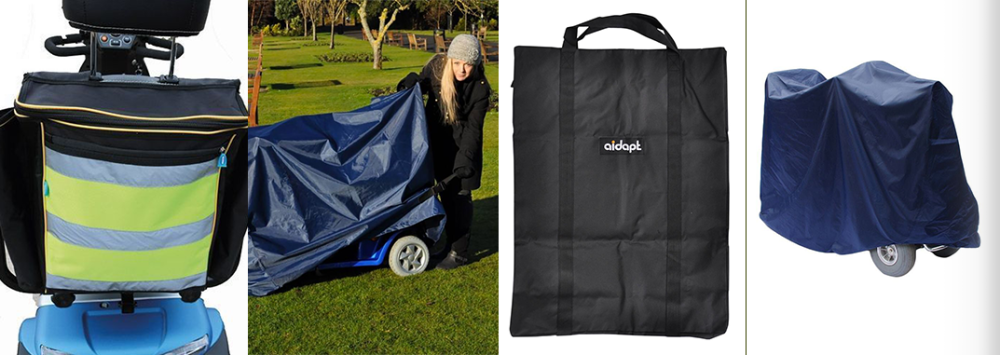
Making a Wheelchair Yours
Sally Madeley-Carr, OT23 Dec 2021
A wheelchair becomes a necessary piece of equipment for several reasons:
- temporary use, whilst rehabilitating from an illness or accident
- temporary use for people whose condition may cause fatigue from time to time e.g. multiple sclerosis (MS), myalgic encephalomyelitis (ME), / chronic fatigue syndrome (CFS) and fibromyalgia
- permanent use for individuals whose mobility is worsening through illness or disability
- permanent use for individuals who have health conditions or disabilities which mean walking is not an option.
People are individuals and so getting the right wheelchair is not a run-of-the-mill purchase. Depending on the individual, their needs, hobbies and aspirations, getting this purchase wrong can detrimentally affect a person's personal development and future.
Different types of wheelchair include the manual wheelchair, a powered / electric wheelchair, sports models, positioning wheelchair designs which can adjust for lying, sitting or standing, all terrain chairs and standing power wheelchair models.
Once the correct wheelchair has been identified and purchased, this item becomes an 'extension of one's own self' and can be personalised by the user.
Personalising a Wheelchair
A wheelchair can be personalised simply by the colour of its soft furnishings but also by the choice of accessories.
Colour aside, accessories can be for comfort, wheelchair protection (against the elements and against theft and harm), promoting independence in both daily living and lifestyle, making travelling a more straightforward option and supporting hobby choices, to name but a few thoughts that need to be correctly planned for.
Wheel covers come in amazing colours and designs and speak volumes about the user's personality and character. These fix easily to the wheels via Velcro strips to every spoke, so the personalised cover dropping off the wheelchair isn't likely to go unnoticed.
Comfort
- Seat pads
Seat pads can make the user more comfortable and help keep irritations such as sores at bay. Once the right size seat pad for the specific wheelchair model has been identified, getting the right material and filling for the individual's needs is vital:
- a foam cushion allows some flexibility of movement and can promote stability / steadiness
- an air cushion offers adjustable firmness and gives extensive pressure relief
- a gel cushion keeps the user cool and also supports distribution of pressure
- honeycomb cushions are light in weight, keep the user cool and offer moderate pressure relief
- An alternating pressure cushion can help prevent sores by doing just that - alternating pressure.
- Other Padding
Padding can be fitted wherever pressure may cause sores and bruising. Items can include:
- leg huggers - if your wheelchair is fitted with a footplate, a leg hugger pad can be attached to lie behind your lower legs. This pad prevents your legs from falling through the gap but can also protect you from the cold which may reach you from under the wheelchair seat
- shoulder and forearm pads can be attached to the wheelchair to give cushioning to these parts of the body, reducing the likelihood of sores and bruises.
- Harnesses and belts
Harnesses and belts are about giving support to the user's body and so the right choice will prove personal to the individual:
- a shoulder harness will support against slouching and so give good back support but may prove restrictive to animated people and to certain tasks and hobbies
- a chest harness will protect the chest but promote fuller movement to the whole of the user's body
- a body harness takes pressure off particular muscles, whilst keeping the full upper body supported
- a pelvic belt can support the pelvic area and support sitting with a straight spine, freeing up your upper body for animated conversation or active sports.
Protection
- Protection against bad weather
Protection against bad weather can be accomplished by covering up with a cosy blanket, mobility scooters covers designed to fit the specific wheelchair and mobility scooter model.
For downpours, snow and even sun, an umbrella holder to support an umbrella or parasol can keep you protected from whatever the day's weather is offering you whilst out and about.
- Protection against theft
Protection against theft is an important consideration and there are several safeguarding options available to the owner:
- keep a record of the wheelchair model and serial numbers, so that quick identification can be made
- mark your wheelchair with an identifiable sticker
- have an up-to-date photo of your wheelchair available, to prove ownership and to secure its return
- fit a locking device, which will make its removal much more difficult
- electronic tracking devices can allow you to track the location of your wheelchair, via an app on your mobile phone.
- Protect yourself against accident during the dark hours
Purchasing a reflective strip, or displaying one which may be on your wheelchair bag, will make you remain visible when out in darkness.
Independence / Daily Living and Lifestyle
- A Working Surface
A working surface is a must for a wheelchair user. It can be used for:
- eating and drinking - should the height of the restaurant table prove to be incompatible with the height of the wheelchair arms (the wheelchair arms are unable to slide under the table), using one's wheelchair table will prove a good second option
- the personal wheelchair table can support writing, reading, accessing a tablet or lightweight laptop, enjoying a hobby or interest, or simply keeping the television remote controls at hand.
- Bags and Pouches
Wheelchair bags, pouches and organisers are a must for individuals who spend a lot of time living, working and participating from their wheelchair.
A wheelchair organiser can fit inside the wheelchair seating area and run along the seat depth, allowing the user immediate access to a mobile phone, glasses, money, make-up, keys, medication and any other small items to which the user may wish personal access.
The organiser can also fit to the back of the wheelchair, though the user may then need assistance in accessing its contents.
Wheelchair bags attach to the back of the wheelchair and can be used for carrying light shopping, college files and other specific items needed in daily life.
- Other Accessories
A drinks holder will prove very useful, particularly if you're trying to multi-function e.g. reading and drinking.
Gloves can be either full-fingered or fingerless, both giving added dexterity and keeping hands free from calluses.
Travelling
For a lightweight manual wheelchair, a carrying case will protect your personal vehicle, by keeping it free from tugs and bumps, as well as spillages. The case will make it easier to slot the wheelchair into allotted space, rather than getting stuck on other strangely shaped objects.
For electric and other non-foldable wheelchairs, a waterproof cover will protect against the elements, spillages and allow the wheelchair to claim some of its own space in the storage area.
Some wheelchair covers have an elastic edge, allowing the cover to be held in place whilst stored.
For users who prefer to operate their wheelchair manually, wheelchair gloves are necessary. Keeping one's hands free from broken skin and sores is a must for regular users. Leather gloves, or thick padded ones, will reduce the likelihood of bruised and blisters.
Accessories for Hobbies and Other Useful Wheelchair Aids
In today's technical world, a table mount (rather like a monitor support) will vertically hold and support items of between ? inch (1 cm) and two inches (5 cm) thick and will promote interests that involve using computers, tablets and books.
Wheelchairs can be fitted with slippers, wheel covers which will stop the outdoor tread on your wheels from staining the carpet, or other flooring in your home or workplace. These come in a variety of colours and can once again personalise your personal mode of transport.
Depending on the individual's personal health condition, other accessories may be needed, including:
- an oxygen tank holder (carrying case) which attaches to the back of the wheelchair
- for electric / powered wheelchairs, a joystick can give the user excellent control of the vehicle, both with adjusting speed, going forward and reversing and also controlling ease of turning, by the use of only two fingers.
- portable wheelchair ramps made from aluminium alloy are lightweight and so prove excellent for entering buildings by the quickest route, rather than taking the longer one of the allocated ramp into the building.
Summary
Matching a wheelchair to the potential user's needs and desires is of paramount importance. Getting it wrong will greatly reduce the user's future development, physically, emotionally and developmentally.
Padding, harnesses and belts all promote comfort and stability, keeping the user 'fresh' and ready for the activities and expectations of the day.
Protecting the user from inclement weather means that the wheelchair is also being protected against the cold and damp, keeping it dry and comfortable for the user and protecting it against excessive wear and tear.
Keep all identifying details for your wheelchair at hand, to support swift retrieval.
At home, the wheelchair table, wheelchair bags and pouches help you keep 'regular' items at hand, reducing the need to move from one place to another, to access run-of-the-mill gadgets and equipment.
When using a joystick for travelling in your electric / powered wheelchair, always find time to practise its capabilities before going out for the first time. Quick pressure on the joystick will cause jerking and so gentle manoeuvres need to be achieved, before being qualified to drive safely.

Sally Madeley-Carr, OT
Sally qualified as an Occupational Therapist in 1996 and is a well-respected professional in the field of rehabilitation equipment and living aids. She has worked in private practice and within the NHS, developing a broad experience with adults and children. Click here for Sally's registration with the Health and Care Professions Council. The HCPC regulates health, psychological and social work professionals in the UK.